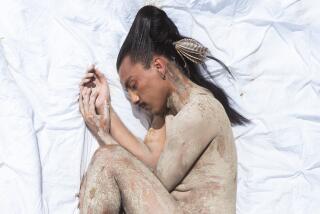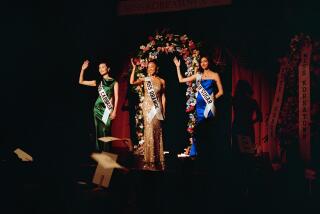Moves in a Journey of Self-Discovery
- Share via
Korean dancer-choreographer Sen Hea Ha is talking about why she shaves her head--to feel and look cleansed, serious and spiritual, it turns out. Which is something you might suspect when you see her impeccably calibrated, ritual-like solo performances.
“People here think I look like a Buddhist monk or nun,” she says, looking today a little like a monk or nun in a hat with down-turned brim, as she sips tea in a Koreatown cafe. But her baldness has a different meaning in other contexts--for instance, in Indonesia, where she has gone for the last few summers to make new work with traditional dancers.
“For them, it means strong, in the middle of gender,” she says in her accented English, speaking softly then definitively as she does when searching for and finding the right word in her second language. “You are feminist, not a woman who is always obeying, and not a man, but in between. To them, it’s American fashion, being modern, Western-looking.”
For Ha, 30, who has built a respected solo career mostly in California and Germany, grappling with the influence of the West has been an ever-present feature of her creative life. It hasn’t been so much a struggle to avoid being co-opted as a journey to discover her own voice.
Trained in traditional Korean dance--from mask and drum dances to the more elegant floating style--Ha decided to come to the U.S. for graduate work at UCLA in the early 1990s. Her idea then was to become a dance critic, which seemed a more serious and respected profession than dancing.
Soon, however, she became interested in dance ethnology--the study of movement practices in various cultures--then in the spiritual aspects of her Korean background and, finally, in choreography. The results have been impressive. The purity and distilled power of her solos have riveted audiences at local venues--this weekend at Highways, she presents a mostly new solo program (with one guest)--and in Germany, Indonesia, New York and Paris.
Along the way, she has attracted the attention of a few theatrical heavyweights--director Peter Sellars and German dance maker Pina Bausch. Both of them saw her dance at UCLA and invited her into their respective companies or projects as a guest artist.
It’s easy to understand their instant enthusiasm when you watch the luminous-faced, rail-thin dancer onstage, moving with an easy but severe grace, as if her life--and yours--depended on meditatively experiencing each moment. To evoke the experience, critics tend to use words like “surrealistic, accomplished gesture,” “solemn grace” and “deep feminine spirituality.”
For Ha, her mission is nothing less than taking the audience on a kind of journey into the world of the spirit.
*
Growing up in Pusan, South Korea, the daughter of a struggling toy manufacturer and a mother who also worked in the factory, Ha was taken by her grandmother to classes in traditional Korean dance at age 4. All through school, she continued to spend a few hours a day dancing, but it was never considered a suitable profession.
“My family was poor. They came from the north after the Korean War, and life was hard for them,” Ha says. “And woman dancing”--she again searches for the right English words--”is not really well-respected.”
Respectability was something that Ha thought about in junior high school, when ballet suddenly became the latest impressive import from the West. She remembers her Korean-dance teacher suddenly deciding they should all embrace ballet. Everyone donned tights and ballet shoes, the teacher got some Western music and then more or less made up the rest.
“It was exciting, something new,” Ha says, laughing at the memory of their enthusiasm and naivete. “And it had more prestige than to say, ‘Oh, I’m a traditional dancer.’ I had pictures of ballerinas and wore my hair up. It became a kind of fantasy for me.”
Later she took real ballet classes and modern dance at college in her hometown, but gravitated much more to traditional dancing. When she graduated, however, she was told that even with good technique, she wasn’t beautiful enough for a shot at the national dance troupes, where dancers tend to be identical-looking. She decided that America was the place to seek out an individual destiny.
Her dance teacher was shocked, and her parents at first disapproved. But then came word from the family shaman, a spiritual advisor whose counsel and interventions with the spirit world are integral for many Koreans: “It’s her life destiny, she has to go. She has to travel the ocean and she will be a success.”
In the United States, Ha didn’t give shamanism much thought at first. But then an anthropology professor casually asked her if there were Korean shamans in Los Angeles. “No,” she said, automatically; then she searched the Yellow Pages and found she was wrong. Her curiosity led to her master’s thesis on the way shamanism is practiced in the Los Angeles Korean community.
She suspects that as many as 80% of Koreans believe in folk religion of shamanism. “The ceremonies are usually for healing, blessing for a business, or to keep you safe,” she explains. “Or maybe for someone who has died and their spirit is still troubled, to make him go to paradise.”
Here as in Korea, Ha discovered, many shamans and their clients are women who may not have other outlets to explore their personal dilemmas. She believes that for everyone, shamanistic ceremonies, which involve singing, dancing and drinking, can provide a safe place for normally repressed emotions to emerge so that healing can take place.
Meeting and sometimes traveling with shamans had a profound effect on the dancer, and she started thinking about changing her profession. But the shamans had better advice. They wanted her to stick with the world of dance in order to reach a different group of people. After finishing her master’s in 1996, Ha also did a master of fine arts in UCLA’s department of world arts and cultures, concentrating on performance. Now, she says, “I continue the tradition in a different way.”
Part of that different way has involved finding a strong choreographic voice. While working with Bausch in Wuppertal, Germany, in 1997, Ha got a crucial clue. “I asked her to watch a 10-minute piece I had done in Los Angeles,” Ha says, “and her comment really shocked me. She had also studied dance in the United States, and she said only one thing: ‘Be careful with things that are American--what you have is so fascinating, don’t just mimic what you see.’ ”
After that, Ha went back to Korea, where she widened her scope to include the influence of Buddhism. Never religious, she took a new look at the serious commitment of the Buddhist monks and nuns, the graceful curves of temple architecture and the dedicated atmosphere. It was just a matter of time before her “funky, short hair style” was doomed. For her, the temples were “something new and fresh,” the same phrase she used to describe the way ballet seemed in her youth.
Only this time the influence felt more resonant and, along with her shamanistic experiences, set her on a path of spiritual dance making.
*
“I fell in love with Sen Hea the very first time I sat in the audience and the lights came up,” says choreographer and UCLA faculty member David Rousseve. “Her focus onstage pulls me in, and I’m so in tune with what she’s doing, communicating about spiritual issues, that it allows me to access that place in myself.
“She’s just the quintessential blend of intuition and purpose, because her themes are so important, but she also has amazing craft, compositionally and technically.”
Rousseve speaks glowingly about two of Ha’s pieces, which are among seven on her Highways program, called collectively “Incarnation.” One solo, “Kuan-Yin,” is based on a goddess figure; another is a duet with Javanese dancer Eko Supriyanto. The two met at UCLA and have worked on the piece for more than a year.
“I work very slowly,” Ha says about her process. “I like to do research, read books, look at pictures.” For a 30-minute solo called “Requiem,” using the Christian-influenced music of Gyorgy Ligeti, Ha tried reading the Bible but found she got more inspiration from religious images and repeated immersion in the music.
Her rehearsal space is close to the cafe in Koreatown, at a yoga studio she is able to use after the last class of the day. She makes her way there now for a class in what is properly called do-in. Two of these classes a day provide her not only with strength and flexibility but also leave her feeling energized and centered--ready for hours of working alone.
In August, she will have a chance to work with a group--Indonesian classical dancers she met a few summers ago, who will appear with her at a Berlin dance festival next June. With them, as with her solo work, she starts with an image, some questions, writing on various topics and a lot of discussion--currently they are exploring thoughts and feelings about mother-child relationships and cultural norms. Only then does the process start to include movement phrases, a choreographic method influenced by the way Bausch works.
Labeling her singular kind of dancing is something that almost silences Ha, as if it were a fascinating question, but one she’d rather dance about than define in words. “I used to say I was a modern dancer,” she says finally, “but now I say I’m a Korean dancer.”
Rousseve says that for him, it’s more complex. “Sen Hea’s work is certainly influenced by her Korean background, but the beauty of the postmodern, contemporary world is that we’re all an amalgam of so many influences. You can see that reflected in her work--the form and the shape of it is absolutely contemporary, it has the focus and timing of Korean dance, some modern vocabulary--and it becomes this incredibly unique expression of exactly who Sen Hea is as a person.”
*
In her yoga class, Ha looks calm and alert at the same time, making pretzel shapes that seem so clear, they are like haiku compared with the rest of the students’ prose. Afterward, she sits on a cushioned bench at the side of a sea of blue carpeting ringed with rice paper screens, wondering if she has expressed herself well enough in words. When everyone clears out of the studio, she’ll start to work and stay until 1 or 2 in the morning, as she does nearly every day.
She worries slightly about whether she will be able to take the audience at Highways along with her on a kind of journey--her two hands glide forward close to each other to demonstrate. It’s a perfect illustration of something Rousseve will say the next day, about watching her dance.
“For me, it’s like meditating or reading a really great book that I have to focus on,” he says. “Afterwards, my mind is just really quiet and at the same time filled with important thoughts and questions that are bubbling for me. It’s just absolutely transporting.”
*
SEN HEA HA IN “INCARNATION,” Highways Performance Space, 1651 18th St., Santa Monica. Dates: Thursday to Saturday. Price: $16. Phone: (310) 315-1459.
More to Read
The biggest entertainment stories
Get our big stories about Hollywood, film, television, music, arts, culture and more right in your inbox as soon as they publish.
You may occasionally receive promotional content from the Los Angeles Times.










